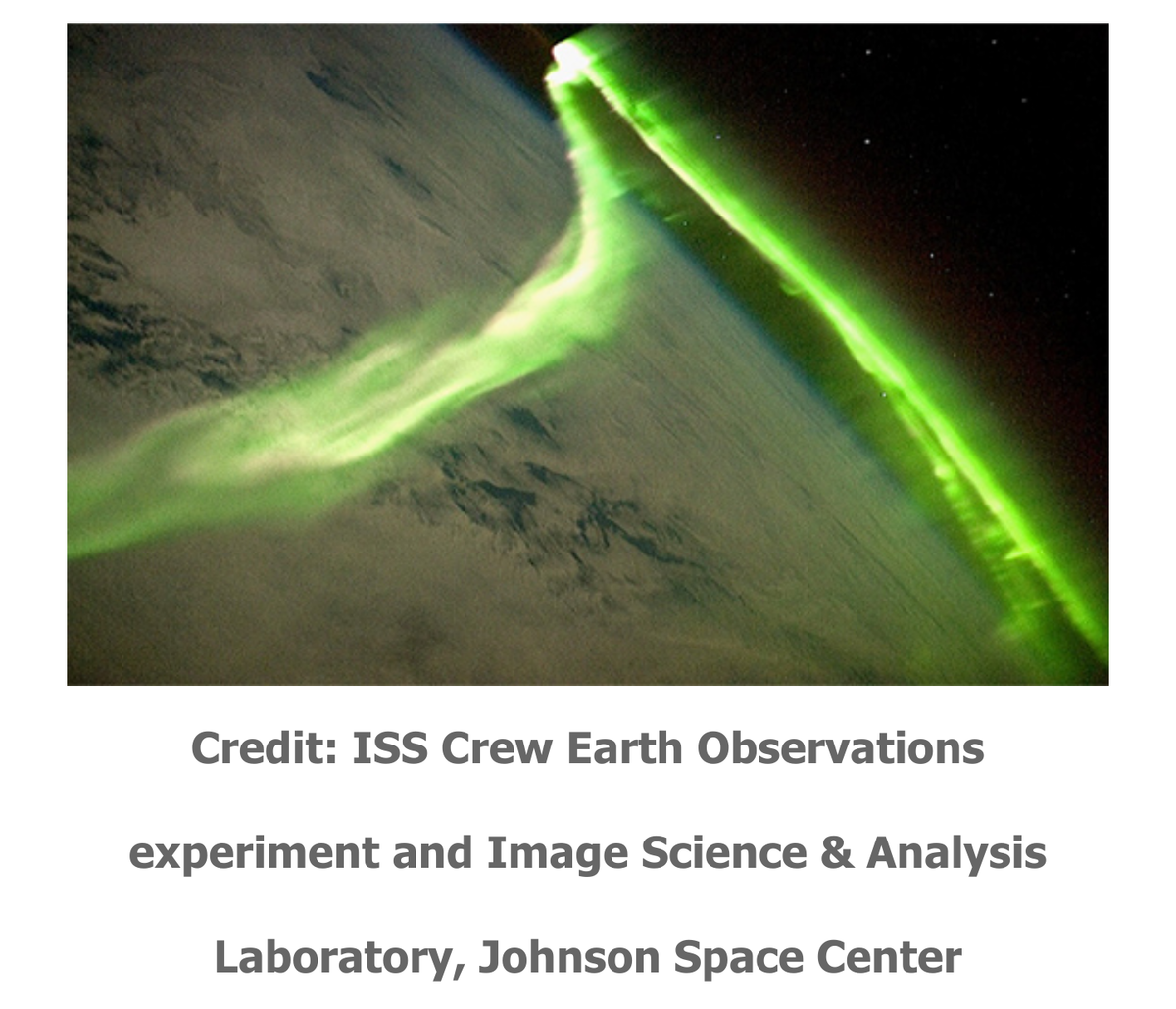ザ・サンダーボルツ勝手連 [Dawn of the North Wind 北の夜明けの風]
[Dawn of the North Wind 北の夜明けの風]
Stephen Smith April 25, 2012 - 22:52Picture of the Day

The Aurora Australis from the ISS.
ISSからのオーロラ・オーストラリス。
―――――――
April 26, 2012
地球のオーロラは、私たちの惑星と太陽の間の電気的接続を示しています。
太陽は2011年10月22日に別のコロナ質量放出(CME)を解き放ち、米国のアーカンソー州のはるか南にある夜間の空で、カラフルなディスプレイの爆発を引き起こしました。
〈https://spaceweather.com/archive.php?view=1&day=24&month=10&year=2011〉
磁気圏尾部(またはプラズマ尾部)と呼ばれる電気的に活性な構造があり、地球から数百万キロメートルにわたって伸びており、常に太陽から離れています。
太陽風と呼ばれる、太陽から放出された荷電粒子の流れは、私たちの惑星の磁気圏によって捕らえられ、磁気圏尾部内のプラズマシートに集められ、私たちの磁場によって一緒に保持されます。
〈https://www.nasa.gov/images/content/517885main_PlasmaSheetProfile.jpg〉
エネルギーの高いイオンが地球の磁場に流れ込み、極に流れ込み、大気中の分子を励起して、さまざまな色の光を放出します:
高高度での酸素からの赤の周波数、低高度での酸素からの緑、および窒素からの青の光を。
〈http://boomeria.org/physicslectures/lawsmotion/aurora.jpg〉
明るいオーロラが見られる場合にも、電磁的不安定性が発生します。
1903年、クリスチャンバークランドとノルウェーの研究チームが北極圏への遠征に着手し、オーロラからの電荷がオーロラ層と平行に流れることを発見しました。
1966年、米海軍の人工衛星TRIADは、地球の極域を通過し、ヴァンアレン放射帯と呼ばれるものを通過する際の磁気擾乱を記録しました。
太陽風から地球に流れるこれらの垂直電流は、1969年にアレックス・デスラーによって「バークランド電流」と名付けられました。
〈https://books.google.com/books/about/The_Northern_Lights.html?hl=ja&id=C9iVxsMjSp4C〉
最近のサブストームの間に、ノルウェーの科学者たちは再びオーロラの輝きの下で地面を流れる電気を検出しました。
バークランドの極電流は、今日ではオーロラ・エレクトロジェットとして知られており、北極および南極地域に出入りする地球の地磁気に続く電気回路に接続されています。
NASAの科学者たちは、この電気効果を「新しい」発見と呼んでいます。
〈https://science.nasa.gov/science-news/science-at-nasa/2009/17dec_whenaurorascollide〉
彼らは発表された論文で電流を認めていますが、従来の理論家はそれらをオーロラ現象の根本的な原因ではなく、プラズマにおける「磁気衝突」効果と見なし続けています。
最新のオーロラエピソードの最も興味深い側面の1つは、その表示ではなく、その起源です。
CMEの直前に、彗星が太陽のコロナに入り、その後再出現しないのが見られました。
〈https://sohowww.nascom.nasa.gov/pickoftheweek/old/21oct2011/〉
以前の「今日の写真の記事」では、大きなCMEの直前に彗星が太陽に「衝突」する他のいくつかの例について説明しました。
〈http://sohowww.nascom.nasa.gov/pickoftheweek/old/03oct2011/C2_CometCME_sm.mov〉
特に1つの彗星、96P /マックホルツ彗星は太陽に衝突しませんでした、それはその周りをかすめました、どうやらその過程でCMEを引き起こしているようです。
太陽物理学者によると、「氷と岩のゆるく一緒に保持された塊」が毎秒2500キロメートルで動く電磁噴火を開始する方法はありません。
彼らが考慮に入れていないのは、太陽系を透過する太陽からの放射状の電場があるということです。
帯電した彗星がそのフィールドを急速に移動すると、彗星の核芯を取り巻く巨大なプラズマシースを横切って突然の崩壊または放電が発生する可能性があります。
太陽の連続放電は動的なプロセスであり、彗星が激しく放電するために提供されるような小さな外部電気トリガーのみを必要とします。
対照的に、天文学者は、単にそれらの巨大な物理的サイズの違いに基づいて、彗星とCMEの間の関係を軽視します。
しかしながら、他のいくつかのサングレーザーは、激しいフレアに関連付けられています。
〈http://soho.nascom.nasa.gov/bestofsoho/Movies/C3_2comets_CME/C3_2comets_CME.mov〉
1つのイベントは偶然であり、2つは長いオッズである可能性がありますが、3つ以上は単なるオッズとして却下することはできません。
編集者注:
この論文のタイトルは「オーロラ・ボレアレス」に由来しています。
―――――――
April 26, 2012
Earth’s aurorae demonstrate the electrical connection between our planet and the Sun.
地球のオーロラは、私たちの惑星と太陽の間の電気的接続を示しています。
The Sun unleashed another coronal mass ejection (CME) on October 22, 2011, causing an outburst of colorful displays in nighttime skies as far south as Arkansas, in the United States.
太陽は2011年10月22日に別のコロナ質量放出(CME)を解き放ち、米国のアーカンソー州のはるか南にある夜間の空で、カラフルなディスプレイの爆発を引き起こしました。
〈https://spaceweather.com/archive.php?view=1&day=24&month=10&year=2011〉
There is an electrically active structure called a magnetotail (or plasma tail) extending for millions of kilometers from Earth, always pointing away from the Sun.
磁気圏尾部(またはプラズマ尾部)と呼ばれる電気的に活性な構造があり、地球から数百万キロメートルにわたって伸びており、常に太陽から離れています。
The flow of charged particles ejected from the Sun, called the solar wind, is captured by our planet’s magnetosphere, collected in a plasma sheet within the magnetotail, and held together by our magnetic field.
太陽風と呼ばれる、太陽から放出された荷電粒子の流れは、私たちの惑星の磁気圏によって捕らえられ、磁気圏尾部内のプラズマシートに集められ、私たちの磁場によって一緒に保持されます。
〈https://www.nasa.gov/images/content/517885main_PlasmaSheetProfile.jpg〉
Energetic ions stream into Earth’s magnetic field down into the poles, exciting atmospheric molecules to the point where they emit various colors of light:
red frequencies from oxygen at high altitudes, green from oxygen at lower altitudes, and blue light from nitrogen.
エネルギーの高いイオンが地球の磁場に流れ込み、極に流れ込み、大気中の分子を励起して、さまざまな色の光を放出します:
高高度での酸素からの赤の周波数、低高度での酸素からの緑、および窒素からの青の光を。
〈http://boomeria.org/physicslectures/lawsmotion/aurora.jpg〉
Electromagnetic instabilities also occur when a bright aurora is seen.
明るいオーロラが見られる場合にも、電磁的不安定性が発生します。
In 1903, Kristian Birkeland and a Norwegian research team undertook an expedition to the Arctic, where they discovered that electric charge from the Aurora Borealis flowed parallel to the auroral formation.
1903年、クリスチャンバークランドとノルウェーの研究チームが北極圏への遠征に着手し、オーロラからの電荷がオーロラ層と平行に流れることを発見しました。
In 1966, the U.S. Navy satellite, TRIAD, recorded those magnetic disturbances as it passed over Earth’s polar regions and through what were named the Van Allen Radiation Belts.
1966年、米海軍の人工衛星TRIADは、地球の極域を通過し、ヴァンアレン放射帯と呼ばれるものを通過する際の磁気擾乱を記録しました。
Those vertical electric currents that flow to Earth from the solar wind were named, “Birkeland currents” by Alex Dessler in 1969.
太陽風から地球に流れるこれらの垂直電流は、1969年にアレックス・デスラーによって「バークランド電流」と名付けられました。
〈https://books.google.com/books/about/The_Northern_Lights.html?hl=ja&id=C9iVxsMjSp4C〉
During the recent substorm, Norwegian scientists again detected electricity flowing through the ground under the auroral glow.
最近のサブストームの間に、ノルウェーの科学者たちは再びオーロラの輝きの下で地面を流れる電気を検出しました。
Birkeland’s polar electric currents are known today as auroral electrojets, and they are connected to electric circuits following Earth’s geomagnetic field into and away from the Arctic and Antarctic regions.
バークランドの極電流は、今日ではオーロラ・エレクトロジェットとして知られており、北極および南極地域に出入りする地球の地磁気に続く電気回路に接続されています。
NASA scientists label this electric effect a “new” discovery.
NASAの科学者たちは、この電気効果を「新しい」発見と呼んでいます。
〈https://science.nasa.gov/science-news/science-at-nasa/2009/17dec_whenaurorascollide〉
Although they acknowledge the electric currents in their published papers, conventional theorists persist in seeing them as “magnetic collision” effects in plasma rather than the fundamental cause of auroral phenomena.
彼らは発表された論文で電流を認めていますが、従来の理論家はそれらをオーロラ現象の根本的な原因ではなく、プラズマにおける「磁気衝突」効果と見なし続けています。
One of the most interesting aspects to the latest auroral episode is not its display, but its origin.
最新のオーロラエピソードの最も興味深い側面の1つは、その表示ではなく、その起源です。
Just before the CME, a comet was seen entering the Sun’s corona and then failing to reappear.
CMEの直前に、彗星が太陽のコロナに入り、その後再出現しないのが見られました。
〈https://sohowww.nascom.nasa.gov/pickoftheweek/old/21oct2011/〉
In previous Picture of the Day articles, several other examples were discussed of comets “crashing” into the Sun just before large CMEs.
以前の「今日の写真の記事」では、大きなCMEの直前に彗星が太陽に「衝突」する他のいくつかの例について説明しました。
〈http://sohowww.nascom.nasa.gov/pickoftheweek/old/03oct2011/C2_CometCME_sm.mov〉
One comet in particular, 96P/Machholz, did not strike the Sun it skimmed around it, apparently causing a CME in the process.
特に1つの彗星、96P /マックホルツ彗星は太陽に衝突しませんでした、それはその周りをかすめました、どうやらその過程でCMEを引き起こしているようです。
According to solar physicists, there is no way for a “loosely held-together blob of ice and rock” to initiate an electromagnetic eruption moving at 2500 kilometers per second.
太陽物理学者によると、「氷と岩のゆるく一緒に保持された塊」が毎秒2500キロメートルで動く電磁噴火を開始する方法はありません。
What they fail to consider is that there is a radial electric field from the Sun permeating the Solar System.
彼らが考慮に入れていないのは、太陽系を透過する太陽からの放射状の電場があるということです。
As charged comets move rapidly through that field, they may experience a sudden breakdown or discharge across the giant plasma sheath surrounding the cometary nucleus.
帯電した彗星がそのフィールドを急速に移動すると、彗星の核芯を取り巻く巨大なプラズマシースを横切って突然の崩壊または放電が発生する可能性があります。
The Sun’s continuous discharge is a dynamic process requiring only a small external electrical trigger like that provided by a comet for it to discharge violently.
太陽の連続放電は動的なプロセスであり、彗星が激しく放電するために提供されるような小さな外部電気トリガーのみを必要とします。
By way of contrast, astronomers discount any relationship between comets and CMEs based simply on their enormous physical size difference.
対照的に、天文学者は、単にそれらの巨大な物理的サイズの違いに基づいて、彗星とCMEの間の関係を軽視します。
However, several other sungrazers have been associated with violent flares.
しかしながら、他のいくつかのサングレーザーは、激しいフレアに関連付けられています。
〈http://soho.nascom.nasa.gov/bestofsoho/Movies/C3_2comets_CME/C3_2comets_CME.mov〉
One event can be a coincidence, two can be long odds, but three or more cannot be dismissed as mere oddities.
1つのイベントは偶然であり、2つは長いオッズである可能性がありますが、3つ以上は単なるオッズとして却下することはできません。
Stephen Smith and Wal Thornhill
スティーブン・スミスとウォル・ソーンヒル
Editor’s note:
This paper’s title comes from “Aurora Borealis”.
編集者注:
この論文のタイトルは「オーロラ・ボレアレス」に由来しています。